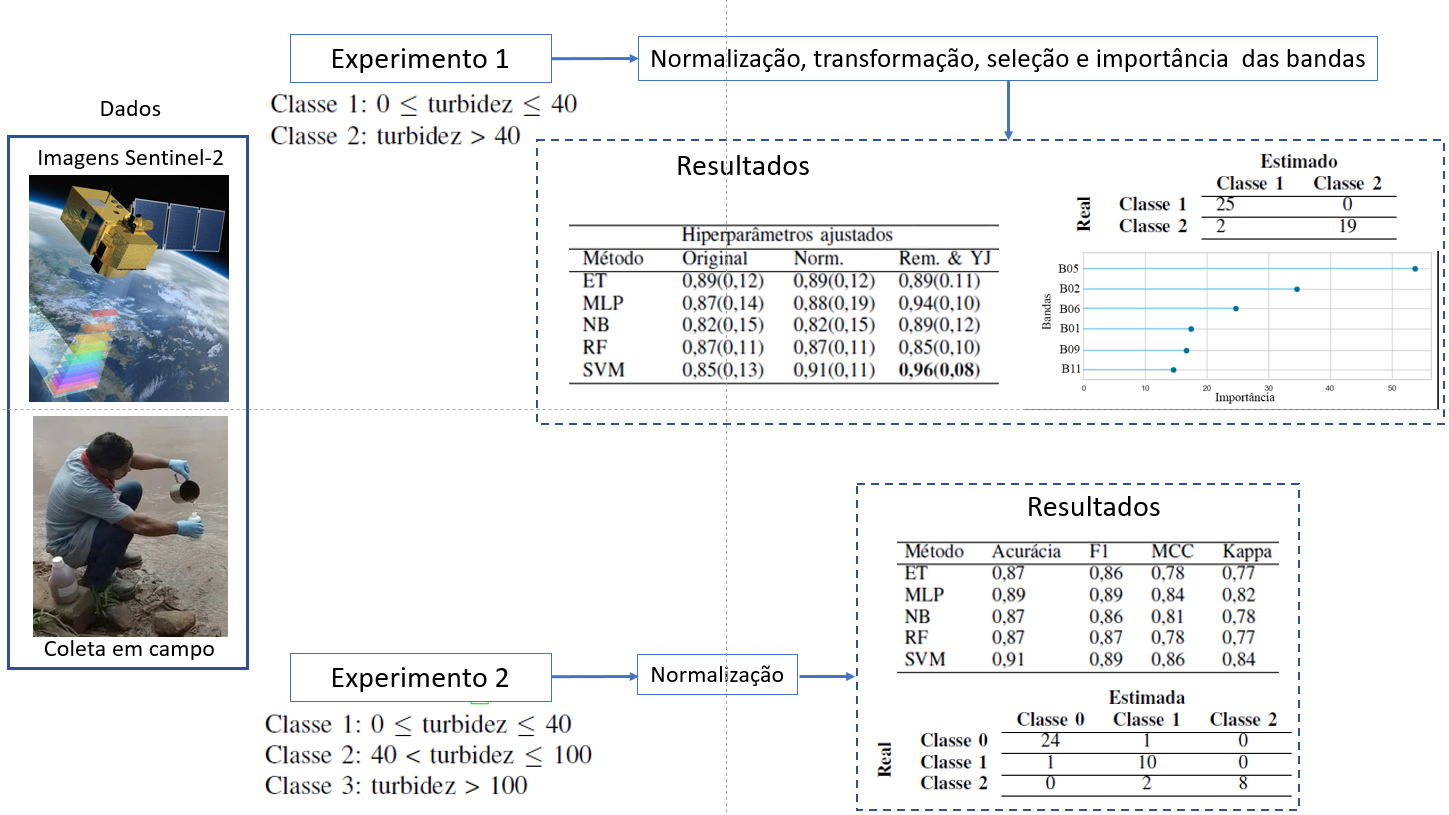Turbidity classification of the Paraopeba River using machine learning and Sentinel-2 images
Keywords:
Machine Learning, Classification, Turbidity, Satellite ImagesAbstract
The collapse of Dam I, owned by Vale S.A, in Brumadinho-MG (Brazil), among other serious socio-environmental consequences, contaminated the waters of the Paraopeba River in a stretch of hundreds of kilometers. Considering the relevance of monitoring water quality, and knowing that field evaluation is a time-consuming and costly procedure, the use of satellite images, widely available at low cost, emerges as a relevant alternative. This work proposes a systematic experimental evaluation of five machine learning methods - Extra Trees, Multilayer Perceptron, Naïve Bayes, Random Forest and Support Vector Machine, under different configurations and input data treatments, to classify the turbidity of the Paraopeba River waters from Sentinel-2 mission images. In a classification setup defined from Brazilian legislation turbidity classes, all methods obtained results equal to or greater than 0.87 accuracy, with appropriate settings and data treatments. The best result was obtained using the Support Vector Machine classifier with hyperparameters adjustment by random search, input data processed by the Yeo-Johnson transformation and selection of spectral bands by collinearity analysis. In this case, the accuracy was 0.96 with two classes, and 0.91 with 3 classes, indicating the feasibility of using this method to classify turbidity.
Downloads
References
A. dos Santos Teixeira, A. S. de Oliveira, F. B. Silva, I. F. Rotondaro, and S. L. S. de Almeida, “Análise do Comportamento dos índices
NDWI Após Rompimento da Barragem de Brumadinho/MG,” in XVII Congresso Nacional do Meio Ambiente, vol. 1, 2020.
F. Thompson, B. C. de Oliveira, M. C. Cordeiro, B. P. Masi, T. P. Rangel, P. Paz, T. Freitas, G. Lopes, B. S. Silva, A. S. Cabral, M. Soares,
D. Lacerda, C. dos Santos Vergilio, M. Lopes-Ferreira, C. Lima, C. Thompson, and C. E. de Rezende, “Severe impacts of the brumadinho
dam failure (minas gerais, brazil) on the water quality of the paraopeba river,” Science of The Total Environment, vol. 705, p. 135914, 2020.
Conselho Nacional dos Direitos Humanos, “Relatório da missão emergencial a Brumadinho/MG após rompimento da barragem da Vale S/A,” 2019.
Agência Nacional de Águas e Saneamento Básico, “Relatório de segurança de barragens 2020,” 2020.
V. M. Cionek, G. H. Z. Alves, R. M. Tófoli, J. L. Rodrigues-Filho, and R. M. Dias, “Brazil in the mud again: lessons not learned from mariana dam collapse,” Biodivers Conserv, vol. 28, pp. 1935—-1938, 2019.
Gerência de Monitoramente de Qualidade das Águas-IGAM-SISEMA, “Qualidade da Água no Rio Paraopeba - Boletim Informativo do
Cidadão, no 24. Maio de 2021.”
Conselho Nacional do Meio Ambiente, “Resolução conama n° 357, de 17 de março de 2005.” https://www.icmbio.gov.br/cepsul/images/stories/legislacao/Resolucao/2005/res_conama_357_2005_classificacao_
corpos_agua_rtfcda_altrd_res_393_2007_397_2008_410_2009_430_2011.pdf.
Conselho Estadual de Política Ambiental, “Deliberação normativa conjunta copam/cerh-mg nº 01, de 05 de maio de 2008.” http://www.siam.mg.gov.br/sla/download.pdf?idNorma=8151.
M. Xu, H. Liu, and Y. Liu, “Multi-predictor ensemble model for river turbidity assessment using landsat 8 imagery at a regional scale,”
in IGARSS 2020 - 2020 IEEE International Geoscience and Remote Sensing Symposium, pp. 4758–4761, 2020.
J. Feng, H. Chen, H. Zhang, Z. Li, Y. Yu, Y. Zhang, M. Bilal, and Z. Qiu, “Turbidity estimation from GOCI satellite data in the turbid estuaries of China’s coast,” Remote Sensing, vol. 12, no. 1, 2020.
Y. O. Ouma, K. Noor, and K. Herbert, “Modelling reservoir chlorophyll-a, TSS, and turbidity using Sentinel-2A MSI and Landsat-8 OLI satellitesensors with empirical multivariate regression,”Journal of Sensors,vol. 2020, no. 1, 2020.
A. Dogliotti, K. Ruddick, B. Nechad, D. Doxaran, and E. Knaeps, “Asingle algorithm to retrieve turbidity from remotely-sensed data in allcoastal and estuarine waters,”Remote Sensing of Environment, vol. 156,pp. 157–168, 2015.
K. Gu, Y. Zhang, and J. Qiao, “Random forest ensemble for river turbi-dity measurement from space remote sensing data,”IEEE Transactionson Instrumentation and Measurement, vol. 69, no. 11, pp. 9028–9036,2020.
F. Güttler, S. Niculescu, and F. Gohin, “Turbidity retrieval and mo-nitoring of Danube delta waters using multi-sensor optical remotesensing data: An integrated view from the delta plain lakes to thewestern–northwestern Black Sea coastal zone,”Remote Sensing ofEnvironment, vol. 132, no. 1, pp. 86–101, 2017.
N. Quang, J. Sasaki, H. Higa, and N. Huan, “Spatiotemporal variation ofturbidity based on landsat 8 oli in cam ranh bay and thuy trieu lagoon,vietnam,”Water, vol. 9, no. 1, 2017.
E. Kari, S. Kratzer, J. Beltrán-Abaunza, E. Harvey, and D. Vaiciute,“Retrieval of suspended particulate matter from turbidity-model deve-lopment, validation, and application to meris data over the baltic sea,”International Journal of Remote Sensing, vol. 38, no. 1, pp. 1983–2003,2016.
F. Pu, C. Ding, Z. Chao, Y. Yu, and X. Xu, “Water-quality classificationof inland lakes using landsat8 images by convolutional neural networks,”Remote Sensing, vol. 11, no. 14, 2019.
F. S. Watanabe, G. T. Miyoshi, T. W. Rodrigues, N. M. Bernardo,L. H. Rotta, E. Alcântara, and N. N. Imai, “Inland water’s trophicstatus classification based on machine learning and remote sensingdata,”Remote Sensing Applications: Society and Environment, vol. 19,p. 100326, 2020.
B. Nechad, K. Ruddick, and G. Neukermans, “Calibration and validationof a generic multisensor algorithm for mapping of turbidity in coastalwaters,” inProceedings of SPIE, vol. 7473, 2009.
European Space Agency, “Sentinel-2 User Handbook - ESA StandardDocument.”
European Space Agency, “Sen2Cor Configuration and User Manual.”
J. Qun’ou, X. Lidan, S. Siyang, W. Meilin, and X. Huijie, “Retrievalmodel for total nitrogen concentration based on uav hyper spectralremote sensing data and machine learning algorithms – a case study inthe miyun reservoir, china,”Ecological Indicators, vol. 124, p. 107356,2021.
A. Yudhana, D. Sulistyo, and I. Mufandi, “Gis-based and naïve bayes fornitrogen soil mapping in lendah, indonesia,”Sensing and Bio-SensingResearch, vol. 33, p. 100435, 2021.
Q. Zhu, “On the performance of matthews correlation coefficient (mcc)for imbalanced dataset,”Pattern Recognition Letters, vol. 136, pp. 71–80, 2020.
“Scikit-learn.” https://scikit-learn.org/stable/. Accesso: 20.07.2021.[26] I.-K. Yeo and R. A. Johnson, “A new family of power transformationsto improve normality or symmetry,”Biometrika, vol. 87, no. 4, pp. 954–959, 2000


